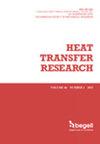评估在蒸汽压缩制冷系统中使用 R410A 和 R463A 的性能:能效分析和环境影响指数(EII)评估
IF 1.6
4区 工程技术
Q3 THERMODYNAMICS
引用次数: 0
摘要
在新一代制冷剂应用于蒸汽压缩制冷循环之前,对其进行全面评估有助于采取审慎的行动。本研究对 R463A 和 R410A 在蒸汽压缩制冷循环中的应用进行了比较分析。R463A 具有显著的优势:由于其在蒸发器温度为 -25°C 时密度较高,因此质量流量较大,从而在 40°C 和 45°C 时具有较强的制冷能力。然而,这种优势是以比 R410A 更高的能源需求为代价的,在这些温度下的能耗增加就是明证。尽管 R463A 制冷剂的制冷能力更强,但其 COP 却略低于 R410A,原因是其压缩机能量利用率更高。此外,随着温度升高,这两种制冷剂的放能破坏都会增加,从而影响放能效率,而 R463A 的放能破坏率较高,因此放能效率略低。环境影响分析还突出表明,在不同温度下,R463A 的环境指数始终高于 R410A。这项综合评估有助于深入了解 R463A 作为蒸汽压缩系统中 R410A 替代制冷剂的性能。本文章由计算机程序翻译,如有差异,请以英文原文为准。
Evaluation of the performance of using R410A and R463A in a vapor compression refrigeration system: Energetic-exergetic analysis and Environmental Impact Index (EII) assessmen
A thorough evaluation of the new generation of refrigerants before their application in vapor compression cooling cycles enables prudent action to be taken. This study presents a comparative analysis between R463A and R410A in vapor compression refrigeration cycles. R463A exhibits notable advantages: it demonstrates higher mass flow rates owing to its elevated density at -25°C evaporator temperature, resulting in superior cooling capacities at 40°C and 45°C. However, this superiority comes at the cost of higher energy demand than R410A, which is evident in its increased energy consumption at these temperatures. Despite its enhanced cooling capacity, R463A displays slightly lower COP attributed to its higher compressor energy utilization. Moreover, both refrigerants exhibit increased exergy destruction with rising temperatures, consequently impacting exergy efficiency, which is slightly lower for R463A due to its elevated exergy destruction rates. Environmental impact analyses also highlight R463A's consistently higher environmental index than R410A across varied temperatures. This comprehensive evaluation contributes insights into R463A's performance as an alternative refrigerant to R410A in vapor compression systems.
求助全文
通过发布文献求助,成功后即可免费获取论文全文。
去求助
来源期刊

Heat Transfer Research
工程技术-热力学
CiteScore
3.10
自引率
23.50%
发文量
102
审稿时长
13.2 months
期刊介绍:
Heat Transfer Research (ISSN1064-2285) presents archived theoretical, applied, and experimental papers selected globally. Selected papers from technical conference proceedings and academic laboratory reports are also published. Papers are selected and reviewed by a group of expert associate editors, guided by a distinguished advisory board, and represent the best of current work in the field. Heat Transfer Research is published under an exclusive license to Begell House, Inc., in full compliance with the International Copyright Convention. Subjects covered in Heat Transfer Research encompass the entire field of heat transfer and relevant areas of fluid dynamics, including conduction, convection and radiation, phase change phenomena including boiling and solidification, heat exchanger design and testing, heat transfer in nuclear reactors, mass transfer, geothermal heat recovery, multi-scale heat transfer, heat and mass transfer in alternative energy systems, and thermophysical properties of materials.
 求助内容:
求助内容: 应助结果提醒方式:
应助结果提醒方式:


